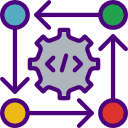Low-code development has rapidly transformed the software industry, allowing users with little to no coding experience to craft robust applications. The recent integration of artificial intelligence (AI) has further propelled this movement by infusing automation, intelligence, and adaptability into development platforms. Leveraging AI within low-code environments delivers newfound efficiency and innovation, making it easier for businesses to accelerate digital transformation. This page explores how the melding of AI with low-code technologies is redefining application development today and what it means for organizations striving for modernization.
Empowering Citizen Developers with AI

AI-powered low-code platforms now offer user-friendly features that automate routine development tasks. These intelligent tools can suggest logic flows, generate code snippets, and even detect errors in real time. The result is a dramatic reduction in the learning curve for non-developers, making sophisticated application creation accessible to a broader audience. As more repetitive and mundane aspects of development are handled by the system, citizen developers can focus on designing processes and interfaces that truly fit their unique business needs, without being bogged down by technical challenges.
Accelerating Development Cycles
01
Automated Code Generation
By leveraging AI to analyze requirements and generate much of the underlying code, low-code platforms can dramatically accelerate the shift from concept to prototype. Developers receive functional code that can be modified and enhanced, significantly shortening development timelines. This automation frees teams to concentrate on tailoring applications to specific business challenges rather than getting bogged down in boilerplate code, boosting both productivity and creativity.
02
Enhanced Testing and Debugging
AI assists in automated testing by intelligently generating test cases, predicting potential points of failure, and identifying bugs or inefficiencies early in the development lifecycle. Swift identification and resolution of issues means fewer bottlenecks and higher-quality end products. The process becomes not only faster but less error-prone, as the AI learns from previous projects to improve its testing strategies and suggestions over time.
03
Streamlined Deployment and Updates
Application deployment and ongoing updates are made more seamless with AI-driven insights. The system anticipates dependencies, compatibility concerns, and integration challenges, guiding developers through safe deployment procedures. Additionally, AI can predict the impact of code changes and help coordinate iterative updates, ensuring that rollouts are smooth and downtime is minimized. Such streamlining is vital for organizations seeking to maintain agility in fast-changing business environments.
Enhancing Application Intelligence
By leveraging embedded AI components, low-code applications can analyze user behavior and preferences in real-time. This enables the app to offer personalized recommendations, adaptive interfaces, and content tailored to individual needs. Businesses benefit from higher engagement, customer satisfaction, and improved conversion rates, as applications become more responsive and user-friendly than ever before.
Join our mailing list
